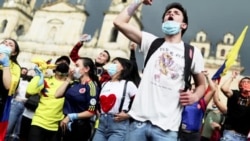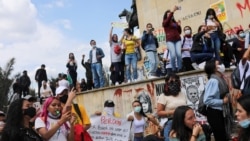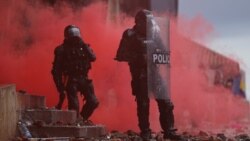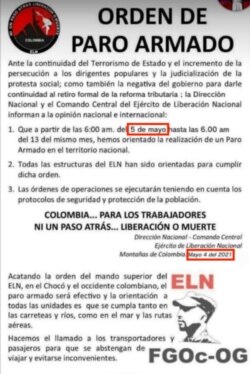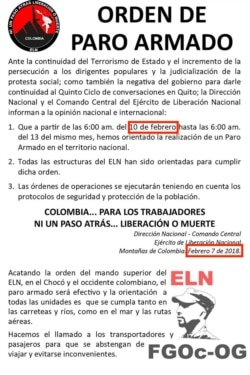On May 3, Diego Molano, Colombia's defense minister, tweeted about the ongoing anti-government protests in the country, which began two weeks ago over controversial fiscal reforms.
“Colombia faces a terrorist threat from criminal organizations, which, disguised as vandals, harass cities like Cali, Bogotá, Medellin, Pereira, Manizales and Pasto, to destabilize. Those have been organized events and financed by dissidents from the FARC and ELN [National Liberation Army].”
But Molano’s statement is misleading. There is little proof criminal groups are behind the protests, and ample evidence they are being driven by popular discontent with the government, particularly a tax reform plan that had to be shelved.
Thousands of Colombians have taken to the streets since April 28 in protests initially sparked by the tax plan. The protests have broadened into an outlet for grievances over poverty, the government’s response to the coronavirus pandemic, COVID-19’s crushing economic effects and excessive use of force by the police.
Several labor unions and social organizations are leading the protests, calling for a nationwide strike.
In an interview with Voice of America, Francisco Maltes Tello, president of the labor union Central Unitaria de Trabajadores de Colombia (CUT) said there are multiple reasons why the strike was called.
“There are 21 million people in poverty who earn less than 11,400 pesos a day (about $3). More than 7,400,000 people in poverty, who earn less than 4,000 pesos a day (a little more than $1).
“We have 17 million people who go to bed hungry. A third of the population, 12 million people, in informal employment, who do not have decent work. More than 4 million unemployed. Last year, more than 500,000 companies went bankrupt,” he said.
For Maltes, the issue of tax reform was only “the tip of the iceberg,” and withdrawing it “does not mean that the country's problems have been solved.”
As of May 7, official numbers say 26 people have died – all but seven related to protests – and 145 are missing in the unrest. Independent groups like the nonprofit Temblores estimate at least 37 deaths, 936 arbitrary detentions and more than 1,770 cases of police violence.
Pressured by the protests, the government withdrew the tax reform plan, and Finance Minister Alberto Carasquilla resigned. After meeting with leaders of the private sector, civil society and lawmakers, President Ivan Duque said a new tax proposal would be drafted. He also agreed to meet with some of the protest groups to “start a dialogue.”
The proposed reform would have raised taxes on services including water, electricity, and natural gas, as well as several basic food items, tech items and funerary services. It also expanded taxation on people who earn more than $656 per month – from $1,000 previously. Colombia’s minimum wage is $248 per month.
The pandemic has added to Colombia’s economic woes. Poverty is up 7 percent since 2019, while two out of five Columbians live in poverty. Additionally, some 2.8 million people fell into extreme poverty last year, reporting earnings of $38 per month.
In major cities, the government deployed the military to control protests, and troops have been accused of abuses that include extrajudicial killings.
The unrest comes against a backdrop of Colombia’s 50-year-long conflict with the left-wing guerrilla group FARC, which in 2016 laid down its weapons after signing a peace accord. Still, FARC rebels and criminal groups remain active and are fighting for control over drug trafficking sources and routes.
In February, a special court found that Colombia’s military had killed at least 6,400 civilians between 2002 and 2008 and passed the deaths off as combat fatalities.
In 2019, Duque’s defense minister resigned after it was reported that at least eight children died when the military bombed a criminal group’s hideout in a remote area.
Gimena Sanchez of the Washington Office on Latin America think-tank told Al Jazeera: “Duque’s unpopularity and perceived distance from the general populace and their interests combined with the economic downturn due to COVID and restrictions, increased insecurity and disinterest in advancing peace will keep these [protests] going.”
The government, however, continues to blame “urban terrorists” for the protests, even as the European Union and organizations like the United Nations, Human Rights Watch and Amnesty International denounced its militarized response.
On May 6, more than a week after the protests started, Colombia's interior minister said the government would not tolerate excessive use of force and would arrest abusive police.
Duque and the country’s attorney general, Francisco Barbosa, claim the protests have been “infiltrated.” During a televised speech on May 5, Duque said “drug-dealing mafias” are financing “urban terrorism and extreme vandalism.”
On May 4, Colombia's attorney general presented the findings of an investigation into what he called “acts of vandalism in establishments and public and private infrastructure” during the protests.
"It has been determined that in the disorders and vandalism that occurred in the city of Cali in recent days, there are structures linked to drug trafficking, the ELN and the FARC dissidents that operate in the department of Cauca," the AG said.
But Barbosa did not provide details. There are currently 185 “urban terrorism” investigations under way around the country, El Pais reported.
The following day, the director of the national police, Jorge Luis Vargas Valencia, announced the caputre of “El Barbado” in the city of Manizales. El Barbado was an alleged ringleader behind acts of vandalism in the city, La Voz de la Dorada reported.
Vargas claimed “El Barbado” is a University of Caldas anthropology student, but he did not report any connections to organizations like FARC or ELN.
Elizabeth Dickinson of the Crisis Group, a research organization that seeks to prevent deadly conflict, told Polygraph.info there has been concrete evidence in the past, as recently as 2019, of dissidents paying protesters to burn buses. "I have no doubt that that's happening [now],” she said. “But I think that it's not widespread."
Online misinformation also has fueled the idea that the protests are being infiltrated and driven by criminal organizations. The fact checking website Colombia Check wrote on May 3 that a video of ELN members allegedly declaring an armed strike and threatening the civilian population had been posted on Facebook and Twitter on April 29 and was also circulating on WhatsApp. In fact, the video was from February 2020.
Similarly, a pamphlet about an order for an armed strike, supposedly also from the ELN, has circulated online in recent days. However, according to Dickinson, "the ELN themselves have told analysts that it's not true." Polygraph.info found the same order circulating online in February 2018 (with different dates).
Dickinson said that even if some members of insurgent groups are taking advantage of the situation, which often happens when the social order is disrupted, "this doesn't justify the militarized response [from Colombian police] against civilian protesters.”
One thing can't cancel the other," she said.
Dickinson argued, this issue should not stain the protests, which are legitimately driven by Colombian citizens.
"The majority, we are talking about 99% of the people on the streets, want to be there and no one is forcing or coercing them to go, she said.




